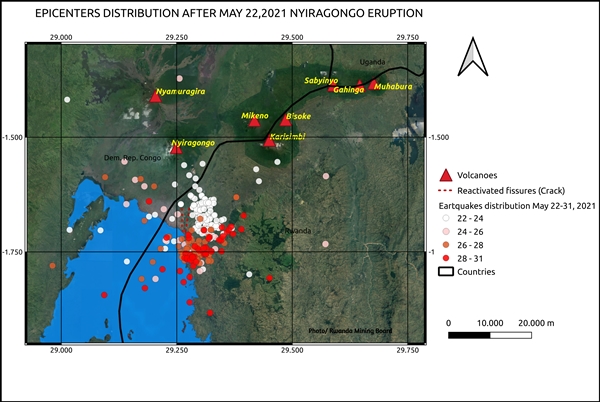
The Lake Kivu monitoring team from Rwanda Environment Management Authority (REMA) based in Rubavu District, has come up with a conclusion that there is no imminent risk of gas outburst expected in Lake Kivu following Nyiragongo volcano eruption on 22nd May 2021.
The team is confident with the results after different measurements and evaluation carried out on the Lake to assess the probable impact of the eruption on Lake Kivu. The lake continues to be stable as it has always been.
“Parameters revealed that the environment remained favorable for aquatic life after Nyiragongo eruption” as indicated in the report from REMA’s Lake Kivu monitoring team.
The team has carried out Physico-chemical measurement of water including temperature, conductivity, oxygen, chlorophyll, and pH, the results “show that the Lake is still stable, and no change was encountered during the measurement period (from 22nd to 27th May 2021)”
During Nyiragongo eruption, many people kept expressing concerns on the impact Nyiragongo eruption would have on Lake Kivu. The lava did not flow in the direction of the Lake, and it gave the assurance that effects of the eruption would not be substantial to the stability of the Lake.
The seismic activities earthquakes epicenters have caused the activation of existing fault that goes all the way to the shore of the Lake.
The Air Quality is also stable
From 27th to 29th May 2021, another team from REMA was in Rubavu District to monitor the Air Quality pollutants associated with Nyiragongo eruption.
RAMPS and ATMOTRACK monitors were used in the monitoring exercise which was running day and night using solar panels as source of energy.
The pollutants of target were SO2, CO2, CO, O3, NO2, PM2.5, PM10, PM1, NH3 and Noise with all Meteorological Parameters including Temperature, Relative Humidity, Pressure, Wind Speed and Wind Direction.
Preliminary findings indicate that all target parameters for Air Quality are falling in acceptable range, and the Real-Time Air Quality data are accessible on REMA AQI Platform (http://aq.rema.gov.rw) and on Phone on “Rwanda AQI” App for Android users.
REMA’s Lake Kivu monitoring team continues to work closely with Rwanda Mines, Petroleum and Gas Board (RMB) and international scientists to monitor if there would be any valuable risk that may arise from the seismic activity on the Lake ecosystem.
In the meantime, the general public and communities around the Lake Kivu are recommended to follow and consider timely and effective official information on the situation.
Lake Kivu is one of the East African great lakes, located at the border between the Republic of Rwanda and the Democratic Republic of the Congo (DRC). The oxic surface waters, called “biozone” by the geochemists or “mixolimnion” by the limnologists, are separated from the anoxic deep waters by a chemocline.
The deep waters of the lake contain high amount of dissolved methane (~55-60 km3) and carbon dioxide (~300 km3), with a reported high risk for local populations in case of release. However, the dissolved methane is a valuable natural resource that is extracted and exploited as a renewable energy for Electricity production in Rwanda.(End).
